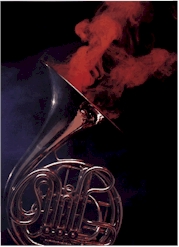









|
FRENCH HORN HISTORY
 |
|
The horn comes from a long tradition of instruments first used in ancient China (2000 B.C.), Egypt (1500 B.C.), and Scandinavia (1000 B.C.). These instruments were used for signaling and ceremony. However, because they had no valves, only a few notes could be played. By Roman times, and for centuries thereafter, valveless “natural” horns were common at military and civilian events.
In the 1600’s the natural horn was used in the royal mounted hunt. The instrument was coiled and fit over the arm of the player who rode with the hunt, playing fanfares and horn calls.
The horn became a regular member of the orchestra during the 1700’s. Early in the century, a horn pitched in F was made in Vienna. This instrument had five detachable pieces of tubing called crooks. Crooks lengthened or shortened the horn so it could be played in the best key for the music. By employing crooks and using the right hand in the bell to stop certain notes, a skilled musician could play any note of the scale.
The invention of valves in 1815 made the awkward crooks obsolete. Two types of valves were developed: rotary (revolving cylinder) valves, and piston (up and down) valves. The French made smaller bored horns with piston valves, while the Germans created larger bored horns with rotary valves. It is the German version that is referred to in America as a French horn.
In 1898, a German named Fritz Kruspe introduced the double horn. The double horn combines the single F and single Bb horns into one instrument. It is widely accepted and played by virtually all professional players today.
French horns are typically made of brass or other metal, usually silver-plated or lacquered. Besides orchestras, they are played in bands, woodwind quintets, and brass ensembles.
(per Standard of Excellence, Book 1)
|
|


